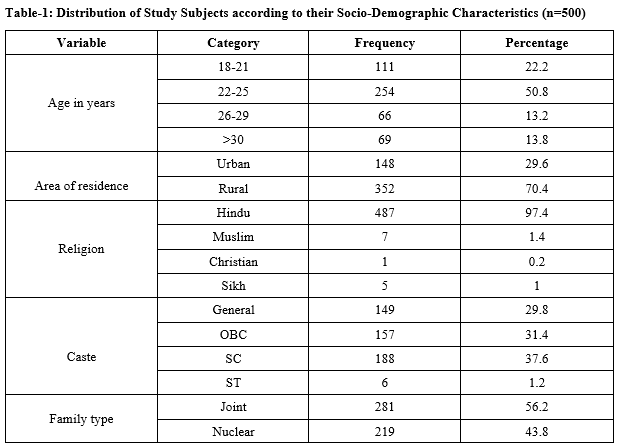Socio-demographic determinants of full antenatal care services utilization among pregnant women delivering at a tertiary care hospital in Haryana
Abstract
Introduction: In India, every year 28 million pregnancies take place of which 67,000 die due to maternal causes and one million women are left with chronic illnesses. Antenatal care is an important determinant of maternal and perinatal mortality. In India, full antenatal care utilization is only 21% (NFHS-4), which is far below the satisfactory level.
Aim & Objectives: To find out the socio-demographic factors affecting the utilization of full antenatal care services among recently delivered women.
Material & Methods: A cross-sectional study was carried out from Feb 2017- Feb 2018 among 500 pregnant females who recently delivered at PGIMS Rohtak. An interview schedule was used for data collection & data were analyzed using SPSS vs 20.0 and appropriate statistical tests were applied.
Results: Out of 500 subjects - 70.4% belonged to rural areas, 97.4% were Hindus, 81.4% were literate, 77.2% were unemployed & only 26.4% belonged to below poverty line. Majority (97%) of participants underwent ANC checkup, 75% got themselves registered in first trimester, 92.2% of study subjects received 2 doses of TT/ booster. 49.9% of study subjects had 4-7 ANC visits, 38.2% of study subjects consumed more than 100 IFA tablets. 61% of study subjects did not receive full ANC. Significant (p< 0.05) association was found between mother’s education & full ANC utilization.
Conclusion: Women and their family members need to be educated about the utilization of ANC services and their role in pregnancy.
Downloads
References
2. Liu L, Oza S, Hogan D, Perin J, Rudan I, Lawn JE, et al. Global, regional, and national causes of child mortality in 2000-13, with projections to inform post-2015 priorities: an updated systematic analysis. Lancet. 2015; 385(9966): 430-440. doi: 10.1016/S0140-6736 (14) 61698-6. Epub 2014 Sep 30.
3. Registrar General of India. Sample registration system (SRS) statistical report 2013. Office of Registrar general of India; New Delhi: 2013.
4. Ghosh-Jerath S, Devasenapathy N, Singh A, Shankar A, Zodpey S. Ante natal care (ANC) utilization, dietary practices and nutritional outcomes in pregnant and recently delivered women in urban slums of Delhi, India: an exploratory cross-sectional study. Reprod Health. 2015;12:20. doi: 10.1186/s12978-015-0008-9.
5. Simkhada B, Teijlingen ER, Porter M, Simkhada P. Factors affecting the utilization of antenatal care in developing countries: systematic review of the literature. J Adv Nurs. 2008;61(3):244-260.doi: 10.1111 /j. 1365-2648.2007.04532.x.
6. Overbosch GB, Nsowah-Nuamah NN, Van den Boom GJ, Damnyag L. Determinants of antenatal care use in Ghana. J Africa Econom. 2004;13(2):277-301.
7. Raatikainen K, Heiskanen N, Heinonen S. Under-attending free antenatal care is associated with adverse pregnancy outcomes. BMC Public Health. 2007;7:268. doi:10.1186/1471-2458-7-268
8. Magadi MA, Madise NJ, Rodrigues RN. Frequency and timing of antenatal care in Kenya: explaining the variations between women of different communities. Soc Sci Med. 2000;51(4):551-561. doi:10.1016/s0277-9536 (99)00495-5
9. Fotso JC, Ezeh AC, Essendi H. Maternal health in resource-poor urban settings: how does women's autonomy influence the utilization of obstetric care services? Reprod Health. 2009;6:9. doi: 10.1186/1742-4755-6-9.
10. Ghai OP, Gupta P. Essential Preventive Medicine: A Clinical and Applied Orientation. Vikas Publishing House Pvt. Limited; 1999.
11. Indian Council of Medical Research. A national collaborative study of identification of high-risk families, mothers and outcome of their offspring with particular references to the problem of maternal nutrition, low birth weight, perinatal and infant morbidity and mortality in rural urban slum countries. New Delhi;1990.
12. Bhattacherjee S, Datta S, Saha JB, Chakraborty M. Maternal health care services utilization in tea gardens of Darjeeling, India. J Bas Clinic Reprod Sci. 2013; 2 (2): 77-84. doi: 10.4103/2278-960X.118645.
13. Pandey S, Karki S. Socio-economic and Demo-graphic Determinants of Antenatal Care Services Utilization in Central Nepal. Int J MCH AIDS. 2014; 2 (2): 212-219.
14. Jahan M, Jahan E. Socio-demographic determinants influencing antenatal care seeking behaviour among women in Bangladesh: an application of factor analysis. Int J Comm Med Pub Health. 2017;3(4):925-930. doi.org/10.18203/2394-6040.ijcmph20160930
15. Adhikari T, Sahu D, Nair S, Saha KB, Sharma RK, Pandey A. Factors associated with utilization of antenatal care services among tribal women: A study of selected States. Indian J Med Res. 2016;144(1):58-66. doi: 10.4103/0971-5916.193284.
16. Kakati R, Barua K, Borah M. Factors associated with the utilization of antenatal care services in rural areas of Assam, India. Int J Comm Med Pub Health. 2016; 3(10): 2799-2805. doi.org/10.18203/2394-6040.ij cmph 20163364
17. Uppadhaya SK, Agrawal N, Bhansali S, Garg K, Singh M. Utilization of antenatal health care services and its impact on birth weight of newborn in rural area of Western Rajasthan, India. Int J Comm Med Pub Health. 2017;4(3): 680-685. doi: http://dx.doi.org/10. 18203 /2394-6040.ijcmph20170739
18. Sharma N, HV KK, Devgan S. A study on utilization of antenatal care services in urban slums of Amritsar city, Punjab, India. Int J Comm Med Pub Health. 2017; 4(3):698-703. doi: http://dx.doi.org/10. 18203/ 2394-6040.ijcmph20170742
19. Iyengar SD, Iyengar K, Gupta V. Maternal health: a case study of Rajasthan. J Health Popul Nutr. 2009;27 (2): 271-292. doi:10.3329/jhpn.v27i2.3369
20. Malik JS, Kalhan M, Punia A, Sachdeva S, Behera BK.Utilization of health services under Janani Suraksha Yojna in rural Haryana.Int J Med Pub Health.2013; 3 (3): 176-179. http://dx.doi. org/10.4103/ 2230-8598. 118977
21. Abdullahi H, Gasim GI, Saeed A, Imam AM, Adam I. Antenatal iron and folic acid supplementation use by pregnant women in Khartoum, Sudan. BMC Res Notes. 2014;7:498. doi: 10.1186/1756-0500-7-498.
22. Zhao Q, Huang ZJ, Yang S, Pan J, Smith B, Xu B. The utilization of antenatal care among rural-to-urban migrant women in Shanghai: a hospital-based cross-sectional study. BMC Public Health. 2012;12: 1012. doi: 10.1186/1471-2458-12-1012.
23. Narayana Murthy MR, Siddalingappa H, Mishra B. Assessment of utilization of antenatal care services by mothers attending immunization sessions at a primary health centre in Mysore district, Karnataka, India. Int J Comm Med Pub Health. 2016;3(9):2561-2565.doi: http://dx.doi.org/10.18203/2394-6040.ijcmph20163072.

Copyright (c) 2019 Author (s). Published by Siddharth Health Research and Social Welfare Society

This work is licensed under a Creative Commons Attribution 4.0 International License.


 OAI - Open Archives Initiative
OAI - Open Archives Initiative


